
- Home
- Listed By
- Material
- Service
- Style
- Subject
- -------- (31)
- --------, Military (8)
- Aircraft (61)
- Aircraft, Military (32)
- Art & Photography (2)
- Eagle (14)
- Education (4)
- History (62)
- History, Military (10)
- Literature & Fiction (4)
- Luftwaffe (8)
- Military (107)
- Military & Political (60)
- Military, -------- (4)
- Mustang (4)
- Paris (2)
- Royal Navy Ship (2)
- Stars (4)
- Transportation (74)
- Women (3)
- Other (721)
- Type
- Art Print (72)
- Art Prints (2)
- Autographed Magazine (5)
- Aviation Art (2)
- Aviation Art Print (3)
- Film (4)
- Hardcover (9)
- Limited Edition (5)
- Lithograph (5)
- Military (7)
- Novel (3)
- Painting (11)
- Photograph (5)
- Print (748)
- Prints (9)
- Ring (2)
- Science / Space (2)
- Sculpture (7)
- Signed Lithograph (2)
- Statue (2)
- Other (312)
Victory over Dunkirk by Robert Taylor Signed limited edition Pilot signed
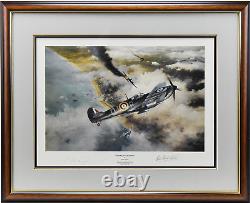
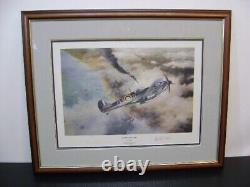
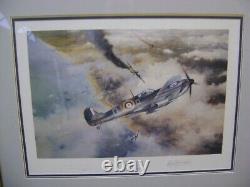

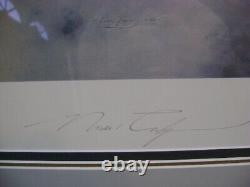


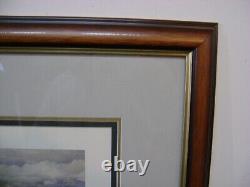

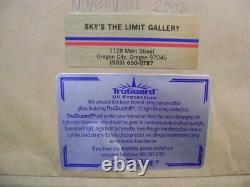
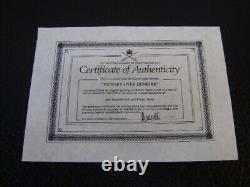
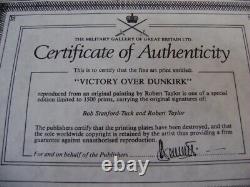

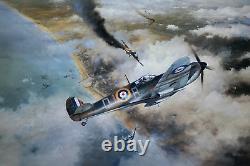



Victory over Dunkirk by Robert Taylor Rare Print, limited edition 1 of 1500. Aircraft - Spitfire Fearless and effective in battle, no matter what the odds, Stanford-Tuck achieved a magnificent 29 aerial victories by 1942 when he was shot down by ground fire over Northern France. Here Bob Stanford-Tuck brings down an enemy aircraft over the port of Dunkirk early in 1940. Signed by Wing Commander Bob Stanford Tuck DSO DFC. Robert Taylor records one of the 3 air victories scored by Bob Stanford-Tuck on his first day in combat.
Few fighter pilots scored a victory on their first day in combat. Bob Stanford-Tuck managed to destroy no fewer than three enemy aircraft on his first engagement with the enemy. Adding credit to this feat, the combat took place during the early part of WWII when most of the time the RAF pilots were heavily outnumbered.
Regarded by many to have been one of the most naturally talented fighter pilots, Bob Stanford-Tuck demonstrated exceptional skill immediately he started flying. He had complete mastery of his machine, be it Spitfire or Hurricane, and an uncanny skill in the art of tactics and deflection shooting in the heat of battle. Fearless and effective in battle, no matter what the odds, Stanford-Tuck achieved a significant 29 aerial victories as early as 1942 when he was shot down by groundfire over Northern France. Robert Taylor's painting depicts Bob Stanford-Tuck destroying his third enemy of the day - a Me110 - over Dunkirk, and Bob's own words when he saw the painting were :The painting is so realistic.That is just how I remember the action. High over the French port of Dunkirk Tuck's 92 squadron spitfire is seen in vertical banking turn with the Me110 streaming smoke way below. Certainly one of the most dramatic aviation paintings depicting the action of the era, collectors will recognise the added value of this fighter Ace's signature. The late Bob Stanford-Tuck was an exuberant character. In 1936 he joined No 65 Squadron, first flying Demons, followed by Gauntlets, Gladiators and then, in 1938, Spitfires.
When war broke out he had already flown several hundred hours on Spitfires. Bob flew his first combat mission on May 23 1940, during the Battle of Dunkirk. Flying a Spitfire with No 92 Squadron, he destroyed an ME109 in the morning and two Me110s later in the same day. He fought an all the great air battles over Dunkirk and the Channel during the build up to the Battle of Britain.
During the Battle he was posted to command No 257 Hurricane Squadron, which had suffered heavy casualties - a post he held until mid 1941, when he took command of the Duxford Fighter Wing. After a brief period in the USA h assumed command of the Biggin Hill Wing consisting of four Spitfire Squadrons.
In January 1942 he was shot down by ground fire during a low-level attack over Northern France by which time he had scored 29 air victories. Each print signed by Robert Taylor and countersigned by Wing Commander Bob Stanford-Tuck.
